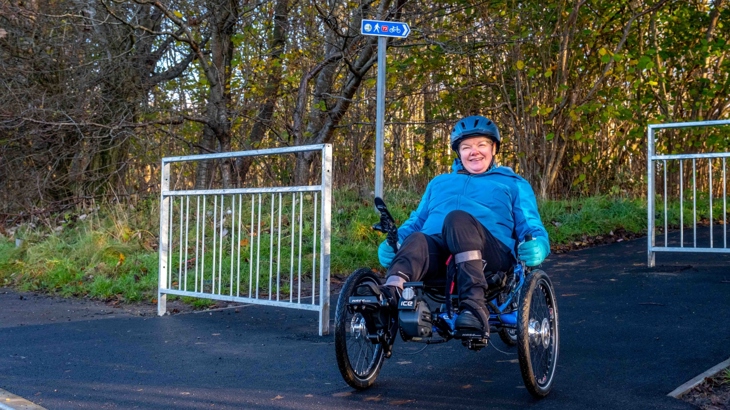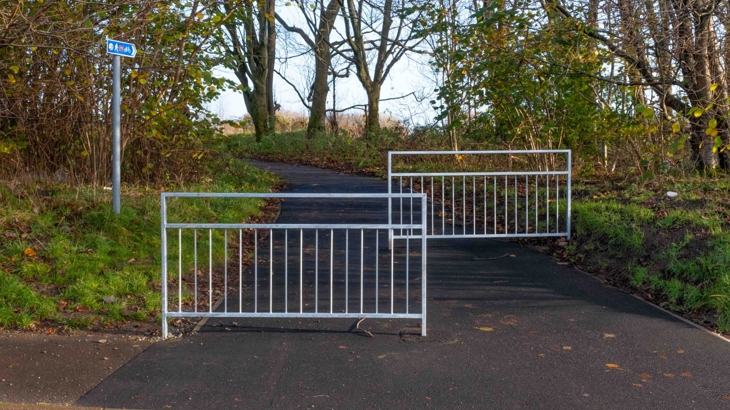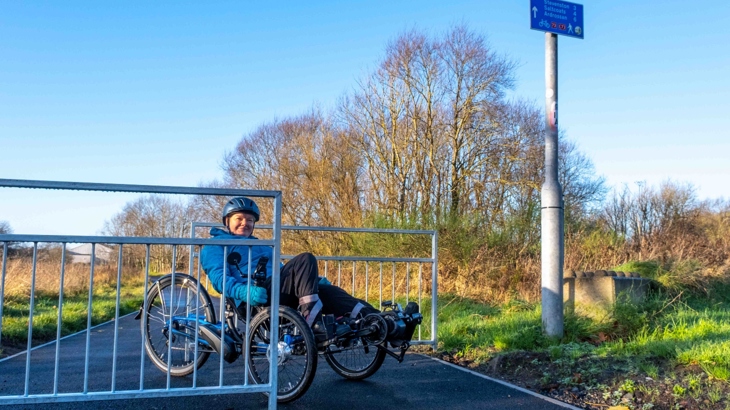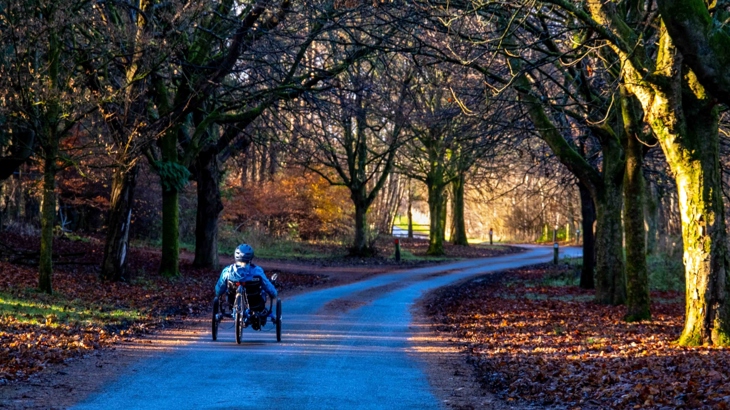Barriers to participation in active travel are often amplified for Disabled people. In this blog we hear from Jane who played a key role in the removal of a barrier on National Cycle Network Route 73 in North Ayrshire. Jane explores why barrier removal is so important and the positive impact that having more accessible routes on the doorstep has had on her life.

Jane riding her recumbent trike. Credit: Sustrans
I started cycling in February of this year.
I have cerebral palsy, so a regular upright bike isn’t suitable for me.
Instead, I ride a type of recumbent trike called an ICE Adventure.
It is low to the ground, great fun to ride and I don’t need to worry about balancing!
It also has an electric assist which means I can cycle for miles.
Using the trike has been incredibly life enhancing.
It is the only method I have of exercising outdoors and has enabled me to get out in the fresh air either independently or together with my friends and family.
The health benefits have been tremendous and being able to get in touch with nature has had such a positive impact on my sense of wellbeing.
Taking up cycling has been one of the best decisions I have ever made.
Discovering a barrier on the National Cycle Network
I am lucky to live near Route 73 of the National Cycle Network.
Traffic-free or virtually traffic-free routes like this are the only safe option for me as I ride low to the ground and am very slow at pedalling.
One day, I set out on a route to get to my local park but, when I was nearly halfway there, I saw an inaccessible barrier in front of me.
My heart sank.
A chicane barrier on the path was so close together it was impossible for me to pass through.
I had no other way of getting to the park and I watched as other people cycling came up behind me, overtook and successfully bypassed the barrier.
I had no option but to turn and head back.

The chicane barrier Jane encountered and reported and the two beyond it have been replaced by accessible ones. Credit: Sustrans
Empowered to take action
I wondered who to ask about having the barrier removed.
I knew that Sustrans promoted the National Cycle Network, so I got in touch with them and was put in contact with the barrier removal team.
They were incredibly helpful and explained that the barrier that was causing me a problem, and the two beyond it, had already been audited.
I was advised to contact my local council and Sustrans provided me with further details that would be useful to them when discussing the case.
With this extra information I contacted one of my local councillors and explained what the removal of the barrier would mean for me.
My local councillor, the Active Travel Hub, and the roads team he liaised with were fantastic.
North Ayrshire Council then applied for the required funding through Sustrans Scotland’s Barrier Removal programme.
I can’t put into words how happy I was when, a few months later, I was on the same route and found the barrier and the two beyond it had been replaced by accessible ones.
The chicanes had been widened and the surface flattened, so I can now glide through the new barriers.

North Ayrshire applied for the required funding through Sustrans Scotland’s Barrier Removal programme. Credit: Sustrans
A significant and lasting impact
The replacement of these barriers has meant that not only have I been able to cycle to the local park, but I have also been able to travel further afield on the rest of the network.
I have cycled through woodland, along riverbanks and nature trails, and explored the local area in a way that just wasn’t possible before.
As I grow stronger, I aim to explore areas which lie even further away.
I am planning to cycle to the Harbourside, another area which lies beyond the barriers, and to Seamill, an area by the beach where barriers were also replaced over the summer.
The work of the barrier removal team at Sustrans and the help of the local council has changed my life for the better.
I will always be thankful for the help they have given me.

The replacement of the barriers has meant that Jane has been able to cycle to the local park, as well as further afield on the rest of the National Cycle Network. Credit: Sustrans
About Sustrans’ Barrier Removal programme
Sustrans Scotland’s Barrier Removal programme is a permanent infrastructure programme.
It offers funding to address access controls and physical restrictions which are located on or preventing direct access to National Cycle Network routes.
It aims to make Network routes more accessible for everyone choosing to walk, wheel or cycle along them.
The programme is funded by the Scottish Government and managed by Sustrans Scotland.
It's open to anyone who owns, manages or has permission to implement change on land that the National Cycle Network runs on in Scotland.
The Barrier Removal programme will next open to applicants in March 2023.





